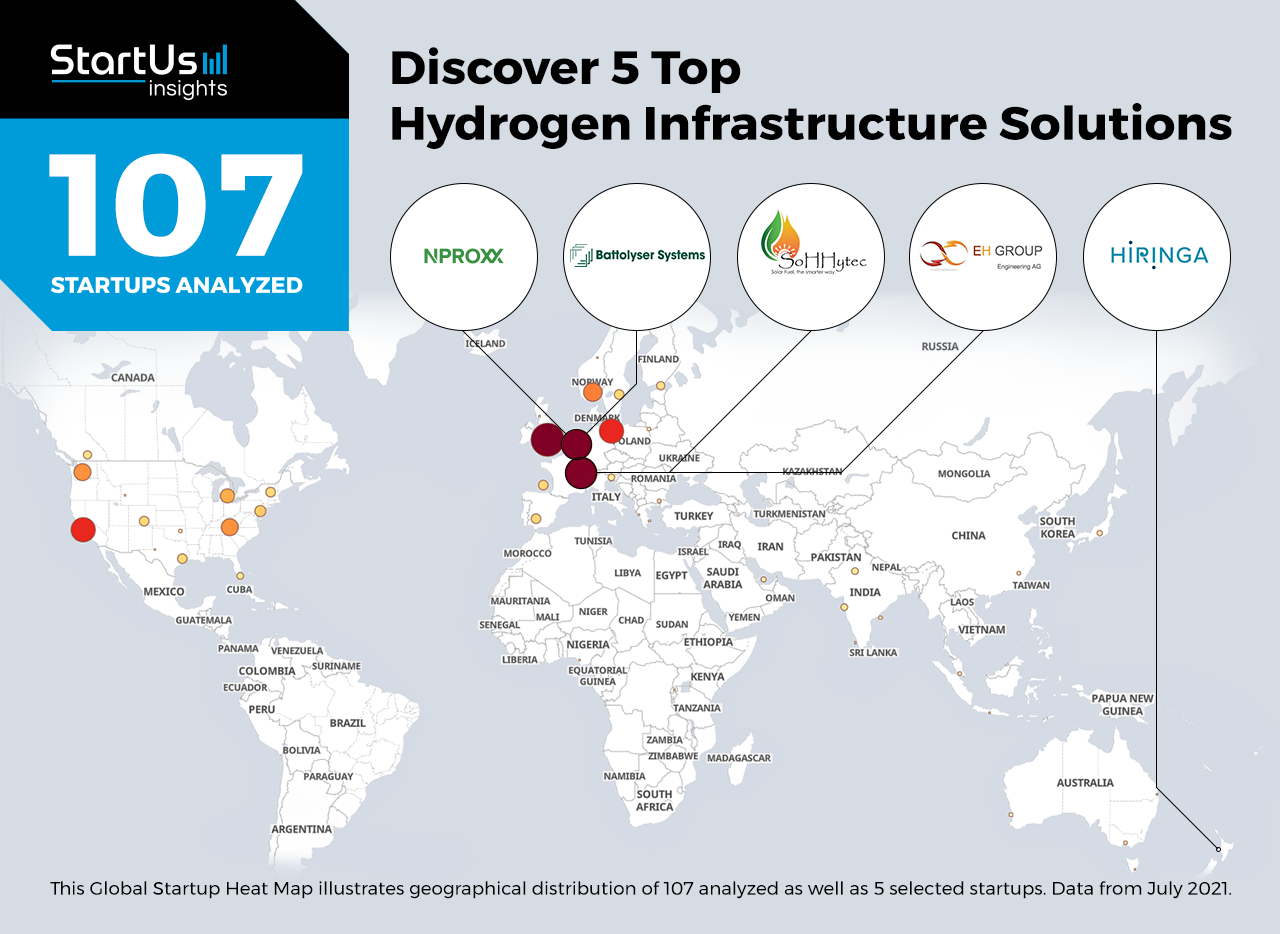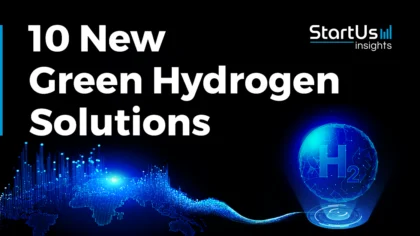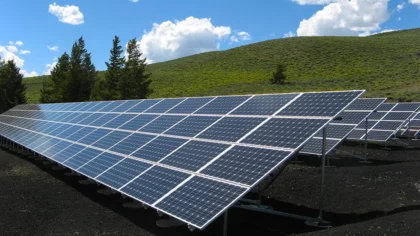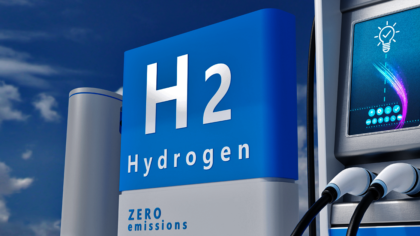Staying ahead of the technology curve means strengthening your competitive advantage. That is why we give you data-driven innovation insights into the hydrogen economy. This time, you get to discover 5 hand-picked startups building hydrogen infrastructure solutions.
Global Startup Heat Map highlights 5 Top Hydrogen Infrastructure Solutions out of 107
The insights of this data-driven analysis are derived from the Big Data & Artificial Intelligence-powered StartUs Insights Discovery Platform, covering 2.093.000+ startups & scaleups globally. The platform gives you an exhaustive overview of emerging technologies & relevant startups within a specific field in just a few clicks.
The Global Startup Heat Map below reveals the distribution of the 107 exemplary startups & scaleups we analyzed for this research. Further, it highlights 5 hydrogen infrastructure startups that we hand-picked based on criteria such as founding year, location, funding raised, and more. You get to explore the solutions of these 5 startups & scaleups in this report. For insights on the other 102 hydrogen infrastructure solutions, get in touch.
Nproxx provides High-Density Hydrogen Storage
Hydrogen has the highest level of energy by mass of any fuel but as the lightest element, it is low in energy by volume. That is why it is necessary to store hydrogen at high densities to make it viable as a fuel for transportation and energy. Startups are working on high-density hydrogen storage solutions to accelerate decarbonization goals and implement hydrogen-based energy systems.
Dutch startup Nproxx develops high-pressure stationary hydrogen storage solutions. Nproxx uses durable and lightweight composites which allows 300 or 500 bar pressure to compactly store hydrogen. This significantly minimizes the storage footprint of hydrogen systems. Nproxx develops stationary storage with more than 1000 kilograms of liquid hydrogen and is suitable for use either at the source of production or at refueling stations and similar facilities.
Hiringa Energy builds a Hydrogen Refueling Network
The lack of hydrogen infrastructure is one of the limiting factors that preventing the adoption of hydrogen-powered vehicles. Refueling stations are the main part of this infrastructure and increasing the number of stations leads to the increasing number of hydrogen vehicles. Startups and emerging companies, along with government support, are planning and building hydrogen refueling networks.
Hiringa Energy is a startup from New Zealand developing a green hydrogen production and refueling network across the country. The current plan focuses primarily on the heavy vehicles market. Hiringa Energy’s three-phase plan extends to 2030 and is expected to install up to 100 refueling stations. For hydrogen generation, the network includes both centralized and decentralized hydrogen production systems as well as plus third-party production to ensure reliable energy supply.
SoHHytec enables Integrated Hydrogen & Heat Production
Today, an overwhelming majority of global hydrogen production is based on reforming conventional fossil fuels, leading to further environmental pollution. This centralized approach also causes other problems such as high transporting costs. That’s why startups are looking for decentralized ways to produce hydrogen using clean and renewable energy.
Swiss startup SoHHytec creates Arb – a solution for hydrogen fuel, energy, and heat production. Arb is based on a patent-pending concentrated integrated-photoelectrochemical (CIPEC) approach. The system uses sunlight, which is concentrated by a factor of 1000 using a parabolic concentrator. Light is then used by Arb’s Pod, which sits at the focus of the parabolic dish. Arb’s Pod utilizes the incoming concentrated sunlight to produce fuel, electricity, and heat at the same time. All systems are backed by a controller to extend the longevity and efficiency of the systems and require only minimal maintenance during the operational years.
Battolyser Systems offers an Integrated Battery & Electrolyzer System
Renewable technologies require power balancing and weather intermittence management to match consumer demand. Also, renewable power sources present the cleanest solutions to produce hydrogen for mobility and stationary usage. Startups are working on ways to combine such energy storage techniques in a single device.
Battolyser Systems is a Dutch startup offering Battolyser – a dual-purpose energy storage solution with a combined battery and electrolyzer function. The Battolyser stores and supplies electricity as a battery and the design improves overall performance. When fully charged, it automatically starts splitting water into hydrogen and oxygen as an electrolyzer. The solution finds multiple applications including continuous hydrogen production for export from large off-grid solar and wind parks and on-site green hydrogen as chemical feedstock for industrial customers. Further, in comparison with traditional Lithium-ion batteries, Battolyser is safer to use and has a longer lifetime.
EH Group creates Advanced Hydrogen Fuel Cells
While hydrogen fuel synthesis is a challenge, improving the efficiency of energy utilization also remains a challenge for the industry. Fuel cells, in particular, have the potential for large-scale use as a stationary or mobile power source. A fuel cell that uses hydrogen and oxygen during its operation only produces water and clean energy. They also have the potential for use in hydrogen-powered vehicles, as backup energy for buildings, and remote or off-grid operations.
Swiss startup EH Group specializes in microstructure technology that creates compact and lightweight hydrogen fuel cells. This design is useful in automotive applications, for example, in buses, trucks, forklifts, boats, or drones, where weight and volume reduction make a significant difference. EH Group’s fuel cells also lower manufacturing costs and enable large-scale deployment in stationary applications such as microgrids, data centers, telecom towers, and hospitals.
Discover more Energy Startups
Energy startups such as the examples highlighted in this report focus on compact hydrogen production technologies, hydrogen refueling networks as well as hydrogen storage solutions. While all of these technologies play a major role in advancing the energy industry, they only represent the tip of the iceberg. To explore more energy technologies, simply get in touch to let us look into your areas of interest. For a more general overview, you can download our free Energy Innovation Report to save your time and improve strategic decision-making.









